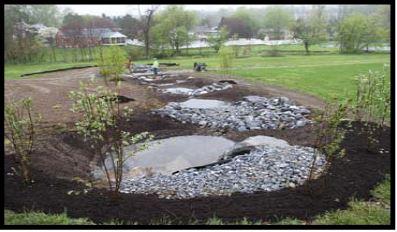

RSC is generally less expensive to construct and easier to secure permitting for than conventional stormwater conveyance projects. What is a Bioswale and a Regenerative Stormwater Conveyance A typical bioswale is long, linear and shallow planted area. A truly regenerative approach, RSC results in a system of physical features, chemical processes and biological mechanisms that dramatically enhance the ecological and aesthetic value of a drainage area. This Best-Management Practice (BMP) is being applied throughout Marylands Coastal plain as a remedy for degraded streams, with the goal that the RSC will help. RSC optimizes the conversion of stormwater to groundwater, reduces erosive energies and increases natural capital. This energy causes erosion, failure of structures and stream channel degradation, which can ultimately lead to lowered shallow groundwater levels, destabilized soils, reduced native vegetation and degraded water quality.Īlternatively, RSC incorporates natural stream channel design techniques and materials, minimizing soil destabilization, vegetation disturbance and invasive plant establishment. A truly regenerative approach, RSC results in. RSCs are designed to convey water while minimizing the effects of erosion. In this study, an RSC was constructed in Knoxville, Tennessee, and monitored for water quality and hydrologic performance over a 16-month period. With conventional stormwater conveyance, runoff from impervious surfaces travels through systems such as pipes and concrete channels, magnifying and transferring energies to the discharge or outfall. RSC optimizes the conversion of stormwater to groundwater, reduces erosive energies and increases natural capital. Description: A regenerative stormwater conveyance (RSC) system provides treatment, infiltration and conveyance through the combination of sand, wood chips, native vegetation, riffles (with either cobble rocks or boulders), and shallow pools. Regenerative Stormwater Conveyance (RSC) is an innovative approach to provide stormwater treatment, infiltration, and conveyance within one system. One such innovative control is the regenerative stormwater conveyance (RSC), which has shown mixed performance based on a limited number of studies to date.


This document is an Environmental Assessment (EA)/Assessment of Effect. This innovative approach to today’s stormwater management challenges, which combines stream channel restoration with improved sediment and nutrient processing, is called Regenerative Stormwater Conveyance (RSC). INSTALLATION OF REGENERATIVE STORMWATER CONVEYANCES AT BINGHAM RUN AND MILKHOUSE RUN. Over 400 participants, including development engineers and local, state, and federal regulators, attended the workshops. Protocol 4: Credit for Dry Channel Regenerative Stormwater Conveyance (RSC) as an. Biohabitats, working with Underwood & Associates and the Anne Arundel County Department of Public Works, developed and delivered a set of five training workshops on the theory and design of open channel coastal plain outfalls using elements of stream restoration, bioretention, and wetland restoration.


 0 kommentar(er)
0 kommentar(er)
